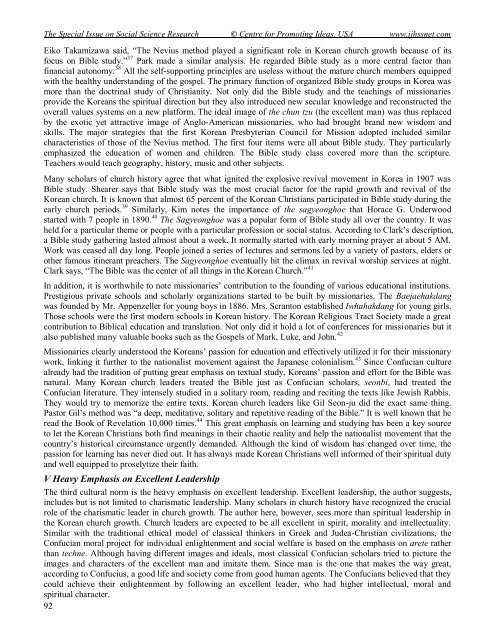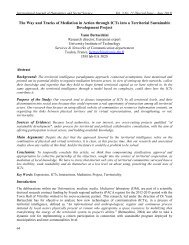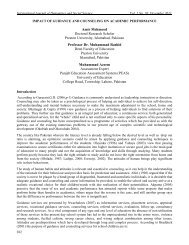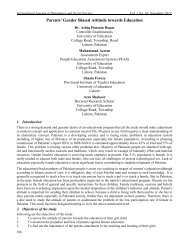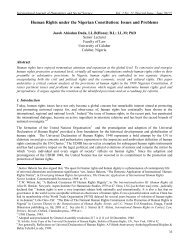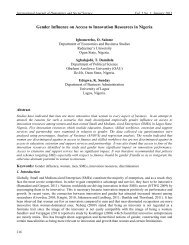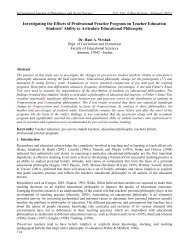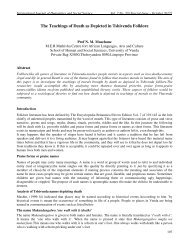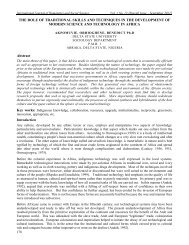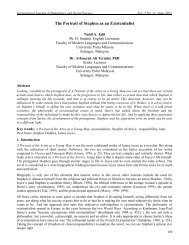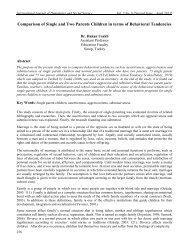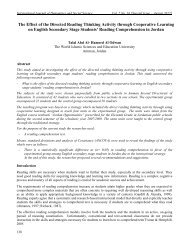Revisiting the Confucian Norms in Korean Church Growth
Revisiting the Confucian Norms in Korean Church Growth
Revisiting the Confucian Norms in Korean Church Growth
Create successful ePaper yourself
Turn your PDF publications into a flip-book with our unique Google optimized e-Paper software.
The Special Issue on Social Science Research © Centre for Promot<strong>in</strong>g Ideas, USA www.ijhssnet.com<br />
Eiko Takamizawa said, “The Nevius method played a significant role <strong>in</strong> <strong>Korean</strong> church growth because of its<br />
focus on Bible study.” 37 Park made a similar analysis. He regarded Bible study as a more central factor than<br />
f<strong>in</strong>ancial autonomy. 38 All <strong>the</strong> self-support<strong>in</strong>g pr<strong>in</strong>ciples are useless without <strong>the</strong> mature church members equipped<br />
with <strong>the</strong> healthy understand<strong>in</strong>g of <strong>the</strong> gospel. The primary function of organized Bible study groups <strong>in</strong> Korea was<br />
more than <strong>the</strong> doctr<strong>in</strong>al study of Christianity. Not only did <strong>the</strong> Bible study and <strong>the</strong> teach<strong>in</strong>gs of missionaries<br />
provide <strong>the</strong> <strong>Korean</strong>s <strong>the</strong> spiritual direction but <strong>the</strong>y also <strong>in</strong>troduced new secular knowledge and reconstructed <strong>the</strong><br />
overall values systems on a new platform. The ideal image of <strong>the</strong> chun tzu (<strong>the</strong> excellent man) was thus replaced<br />
by <strong>the</strong> exotic yet attractive image of Anglo-American missionaries, who had brought brand new wisdom and<br />
skills. The major strategies that <strong>the</strong> first <strong>Korean</strong> Presbyterian Council for Mission adopted <strong>in</strong>cluded similar<br />
characteristics of those of <strong>the</strong> Nevius method. The first four items were all about Bible study. They particularly<br />
emphasized <strong>the</strong> education of women and children. The Bible study class covered more than <strong>the</strong> scripture.<br />
Teachers would teach geography, history, music and o<strong>the</strong>r subjects.<br />
Many scholars of church history agree that what ignited <strong>the</strong> explosive revival movement <strong>in</strong> Korea <strong>in</strong> 1907 was<br />
Bible study. Shearer says that Bible study was <strong>the</strong> most crucial factor for <strong>the</strong> rapid growth and revival of <strong>the</strong><br />
<strong>Korean</strong> church. It is known that almost 65 percent of <strong>the</strong> <strong>Korean</strong> Christians participated <strong>in</strong> Bible study dur<strong>in</strong>g <strong>the</strong><br />
early church periods. 39 Similarly, Kim notes <strong>the</strong> importance of <strong>the</strong> sagyeonghoe that Horace G. Underwood<br />
started with 7 people <strong>in</strong> 1890. 40 The Sagyeonghoe was a popular form of Bible study all over <strong>the</strong> country. It was<br />
held for a particular <strong>the</strong>me or people with a particular profession or social status. Accord<strong>in</strong>g to Clark‟s description,<br />
a Bible study ga<strong>the</strong>r<strong>in</strong>g lasted almost about a week. It normally started with early morn<strong>in</strong>g prayer at about 5 AM.<br />
Work was ceased all day long. People jo<strong>in</strong>ed a series of lectures and sermons led by a variety of pastors, elders or<br />
o<strong>the</strong>r famous it<strong>in</strong>erant preachers. The Sagyeonghoe eventually hit <strong>the</strong> climax <strong>in</strong> revival worship services at night.<br />
Clark says, “The Bible was <strong>the</strong> center of all th<strong>in</strong>gs <strong>in</strong> <strong>the</strong> <strong>Korean</strong> <strong>Church</strong>.” 41<br />
In addition, it is worthwhile to note missionaries‟ contribution to <strong>the</strong> found<strong>in</strong>g of various educational <strong>in</strong>stitutions.<br />
Prestigious private schools and scholarly organizations started to be built by missionaries. The Baejaehakdang<br />
was founded by Mr. Appenzeller for young boys <strong>in</strong> 1886. Mrs. Scranton established Iwhahakdang for young girls.<br />
Those schools were <strong>the</strong> first modern schools <strong>in</strong> <strong>Korean</strong> history. The <strong>Korean</strong> Religious Tract Society made a great<br />
contribution to Biblical education and translation. Not only did it hold a lot of conferences for missionaries but it<br />
also published many valuable books such as <strong>the</strong> Gospels of Mark, Luke, and John. 42<br />
Missionaries clearly understood <strong>the</strong> <strong>Korean</strong>s‟ passion for education and effectively utilized it for <strong>the</strong>ir missionary<br />
work, l<strong>in</strong>k<strong>in</strong>g it fur<strong>the</strong>r to <strong>the</strong> nationalist movement aga<strong>in</strong>st <strong>the</strong> Japanese colonialism. 43 S<strong>in</strong>ce <strong>Confucian</strong> culture<br />
already had <strong>the</strong> tradition of putt<strong>in</strong>g great emphasis on textual study, <strong>Korean</strong>s‟ passion and effort for <strong>the</strong> Bible was<br />
natural. Many <strong>Korean</strong> church leaders treated <strong>the</strong> Bible just as <strong>Confucian</strong> scholars, seonbi, had treated <strong>the</strong><br />
<strong>Confucian</strong> literature. They <strong>in</strong>tensely studied <strong>in</strong> a solitary room, read<strong>in</strong>g and recit<strong>in</strong>g <strong>the</strong> texts like Jewish Rabbis.<br />
They would try to memorize <strong>the</strong> entire texts. <strong>Korean</strong> church leaders like Gil Seon-ju did <strong>the</strong> exact same th<strong>in</strong>g.<br />
Pastor Gil‟s method was “a deep, meditative, solitary and repetitive read<strong>in</strong>g of <strong>the</strong> Bible.” It is well known that he<br />
read <strong>the</strong> Book of Revelation 10,000 times. 44 This great emphasis on learn<strong>in</strong>g and study<strong>in</strong>g has been a key source<br />
to let <strong>the</strong> <strong>Korean</strong> Christians both f<strong>in</strong>d mean<strong>in</strong>gs <strong>in</strong> <strong>the</strong>ir chaotic reality and help <strong>the</strong> nationalist movement that <strong>the</strong><br />
country‟s historical circumstance urgently demanded. Although <strong>the</strong> k<strong>in</strong>d of wisdom has changed over time, <strong>the</strong><br />
passion for learn<strong>in</strong>g has never died out. It has always made <strong>Korean</strong> Christians well <strong>in</strong>formed of <strong>the</strong>ir spiritual duty<br />
and well equipped to proselytize <strong>the</strong>ir faith.<br />
V Heavy Emphasis on Excellent Leadership<br />
The third cultural norm is <strong>the</strong> heavy emphasis on excellent leadership. Excellent leadership, <strong>the</strong> author suggests,<br />
<strong>in</strong>cludes but is not limited to charismatic leadership. Many scholars <strong>in</strong> church history have recognized <strong>the</strong> crucial<br />
role of <strong>the</strong> charismatic leader <strong>in</strong> church growth. The author here, however, sees more than spiritual leadership <strong>in</strong><br />
<strong>the</strong> <strong>Korean</strong> church growth. <strong>Church</strong> leaders are expected to be all excellent <strong>in</strong> spirit, morality and <strong>in</strong>tellectuality.<br />
Similar with <strong>the</strong> traditional ethical model of classical th<strong>in</strong>kers <strong>in</strong> Greek and Judea-Christian civilizations, <strong>the</strong><br />
<strong>Confucian</strong> moral project for <strong>in</strong>dividual enlightenment and social welfare is based on <strong>the</strong> emphasis on arete ra<strong>the</strong>r<br />
than techne. Although hav<strong>in</strong>g different images and ideals, most classical <strong>Confucian</strong> scholars tried to picture <strong>the</strong><br />
images and characters of <strong>the</strong> excellent man and imitate <strong>the</strong>m. S<strong>in</strong>ce man is <strong>the</strong> one that makes <strong>the</strong> way great,<br />
accord<strong>in</strong>g to Confucius, a good life and society come from good human agents. The <strong>Confucian</strong>s believed that <strong>the</strong>y<br />
could achieve <strong>the</strong>ir enlightenment by follow<strong>in</strong>g an excellent leader, who had higher <strong>in</strong>tellectual, moral and<br />
spiritual character.<br />
92


